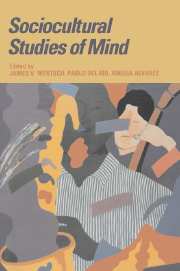Book contents
- Frontmatter
- Contents
- Series Foreword
- List of contributors
- Sociocultural studies: history, action, and mediation
- Part I Human action: historical and theoretical foundations
- 1 Cultural–historical psychology and the psychological theory of activity: retrospect and prospect
- 2 The need for action in sociocultural research
- 3 Theories of action, speech, natural language, and discourse
- Part II Mediation in action
- Part III Sociocultural setting, intersubjectivity, and the formation of the individual
- Part IV Sociocultural settings: design and intervention
- Index
1 - Cultural–historical psychology and the psychological theory of activity: retrospect and prospect
Published online by Cambridge University Press: 05 June 2012
- Frontmatter
- Contents
- Series Foreword
- List of contributors
- Sociocultural studies: history, action, and mediation
- Part I Human action: historical and theoretical foundations
- 1 Cultural–historical psychology and the psychological theory of activity: retrospect and prospect
- 2 The need for action in sociocultural research
- 3 Theories of action, speech, natural language, and discourse
- Part II Mediation in action
- Part III Sociocultural setting, intersubjectivity, and the formation of the individual
- Part IV Sociocultural settings: design and intervention
- Index
Summary
Vygotsky's account of cultural-historical psychology emerged just when the silver age, or renaissance, of Russian culture was in decline. During this age there were no sharp divisions of labor among science, art, aesthetics, philosophy, and even theology. Gustav Shpet, Aleksei Losev, Mikhail Bakhtin, Pavel Florenskii, and the major founder of culturalhistorical psychology, Lev Vygotsky, were simultaneously scholars and connoisseurs of these spheres of human activity. The ideas of Vladimir Solov'ev about the “unity in all” of rational and spiritual knowledge were still alive. The remarkable poets Boris Pasternak and Osip Mandel'shtam were deeply schooled in philosophy and the sciences.
A major characteristic of cultural-historical psychology was its tendency to integrate knowledge about humans by drawing on various approaches and methods. In its first stages, the genetic method of research was dominant. Subsequently, other methods such as functionalgenetic and functional-structural analyses (including microgenetic, macrostructural, and microdynamic) emerged to complement the genetic method. This amounted to an extension and enrichment of the initial ideas of Vygotsky and an attempt to address a mass of empirical material.
During the development of cultural-historical psychology, there were not only additions, but losses, or simplifications, in the original corpus of ideas. The spiritual component of the “unity in all” was lost, which amounted to its destruction. There was a narrowing of the idea of mediation. In Vygotsky we find three main mediators: sign, word, and symbol. In the course of the development of his school of thought, the symbol was lost.
- Type
- Chapter
- Information
- Sociocultural Studies of Mind , pp. 37 - 55Publisher: Cambridge University PressPrint publication year: 1995
- 20
- Cited by

